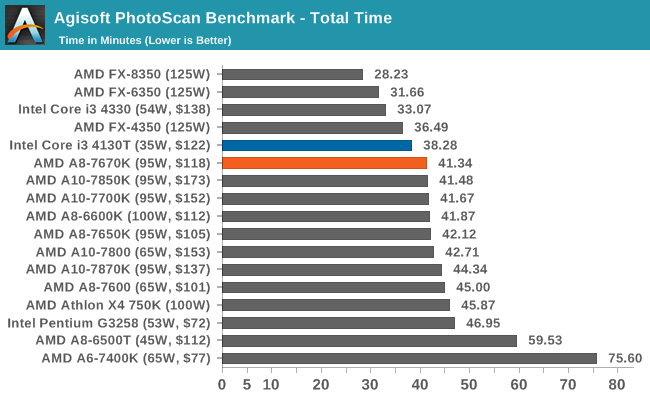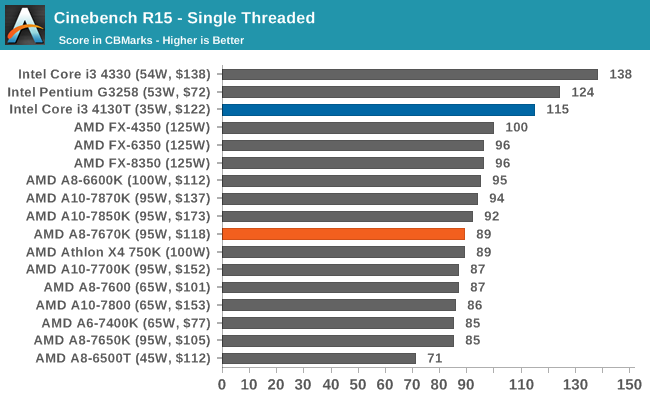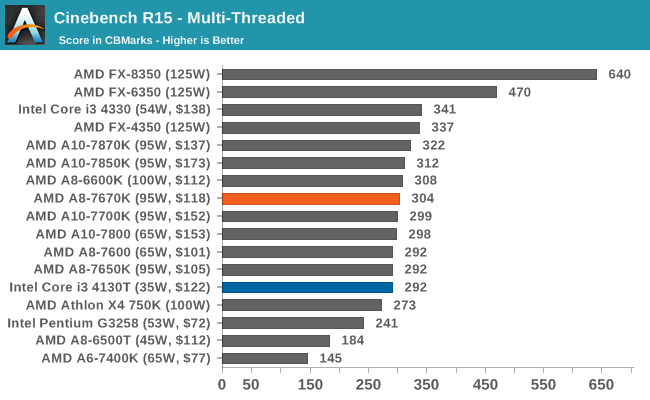The AMD A8-7670K APU Review: Aiming for Rocket League
by Ian Cutress on November 18, 2015 8:00 AM ESTProfessional Performance: Windows
Agisoft PhotoScan – 2D to 3D Image Manipulation: link
Agisoft PhotoScan creates 3D models from 2D images — a process that is very computationally expensive. The algorithm is split into four distinct phases, and different phases of the model reconstruction require either fast memory, fast IPC, more cores, or even OpenCL compute devices to achieve the best performance. Agisoft supplied us with a special version of the software to script the process, where we take 50 images of a stately home and convert it into a medium-quality model. This benchmark typically takes around 15 to 20 minutes on a high-end PC on the CPU alone, with GPUs reducing the time.

PhotoScan shows most APUs performing around 41 to 42 minutes, which suggests that there is a bottleneck in the core design.
Cinebench R15
Cinebench is a benchmark based around Cinema 4D, and is fairly well known among enthusiasts for stressing the CPU for a provided workload. Results are given as a score, where higher is better.


HandBrake v0.9.9: link
For HandBrake, we take a video (a 2h20 640x266 DVD rip) and convert it to x264 format in an MP4 container. Results are given in terms of the frames per second processed, and HandBrake uses as many threads as possible.











154 Comments
View All Comments
milli - Thursday, November 19, 2015 - link
Sounds good :)BrokenCrayons - Thursday, November 19, 2015 - link
95 watts is too much for a modern CPU to require.plonk420 - Thursday, November 19, 2015 - link
that's watts TDP, not watts at the wall.BrokenCrayons - Friday, November 20, 2015 - link
Yes, that's fine. It's too high for a modern CPU. Half that would be more reasonable and a tenth would be better still, but not at all perfect.TheinsanegamerN - Friday, November 20, 2015 - link
The i3 is still a 47 watt chip. the skylake i7s are 95 watt. It seems most "modern" cpus are in the 65-95 watt range, with 47 watt for dual cores.A tenth of 95 watt is only 9.5, which is core m territory. it works, but it ISNT for power users. So i'm not sure what 'modern' cpu you are referring to, as it doesn't seem to exist. And AMD's APUs can be set to 65 or 45 watt mode as well, but you get a performance hit. So half the TDP already exists, and a tenth is too little for a big CPU.
BrokenCrayons - Friday, November 20, 2015 - link
Yes, the i3 is an Intel processor. Skylake's 95 watt chip is an outlier that's highly uncommon. The vast majority of computers purchased are inexpensive laptops which regularly only rise to 35 watts. Desktop processors are not only a rarity, but those that range above 65 watts are very uncommon and largely the domain of expensive workstations and the very small number of gaming systems out there. It's pretty odd of AMD to sell a budget processor that puts those kinds of demands on a system and, in my opinion, unreasonable given the competition in the same approximate performance.silverblue - Friday, November 20, 2015 - link
I know it's hardly comparable, but I wonder what power an i3 with Godavari-level GPU would use if at 28nm. Besides, TDP != actual power usage.TheinsanegamerN - Friday, November 20, 2015 - link
Desktops are rare now? Ok. You must not work in business. Desktops Are still common, not as much as laptops, but the forecast for all of 2015 was north of 120 million desktops, the vast majority of which are business machines with i5 processors, which are 65-84 watt. I7s are rated at 84 watt for haswell, 77 for ivy bridge, and 95 for sandy bridge, and 95 for skylake, so it's much more common than you think.As for laptops, I'm not sure why you brought them up, seeing as the a8 is a DESKTOP chip. on DESKTOPs, CPUs with 65 watt TDPs are very common. Any i5, i7, pretty much any APU from AMD, are all 65 watt+. Laptops typically use dual core chips with much lower clock rates and power restricted GPUs. The vast majority of laptops, with those 35 watt chips (and most of the skylake and broadwell chips in laptops are 15 watt BTW, 35 watt isn't really used much anymore) can't compare to a 95 watt desktop chip in performance, so it still won't work for power users.
So when you say that the TDP is too high for a modern processor, you mean it's too much for a mobile processor, ignoring that this is a processor for desktops. Unless you want a desktop processor with a mobile TDP but desktop performance, which will never happen, because a higher TDP chip will be clocked higher. Always.
Deshi - Friday, November 20, 2015 - link
Does that 95 watts include the onboard GPU? if thats the case, thats not so bad, since you would need to addin the added dGPU TDP if you build an intel + nvidia/radeon to match the performance.nos024 - Thursday, November 19, 2015 - link
blah...after 4 years and Intel's IGP is still on the heels of AMD's APU. Bleh.Give me graphics performance comparable to a 750ti and an ITX motherboard with M.2 storage option and I'll will go and buy it this very instance. I want something like that.
Low profile ITX-case + 8gb RA
M + 240/256GB M.2 RAM (SATA or PCIe) + 300W PSU + ITX MB with AC wireless + APU with 750ti GPU performance. Is that so hard to ask for?! Apparantly so.